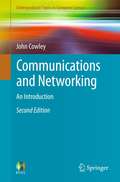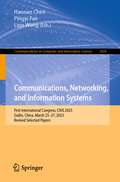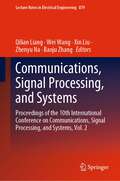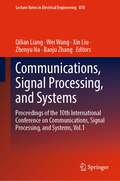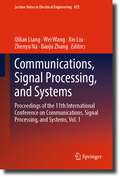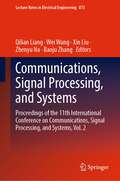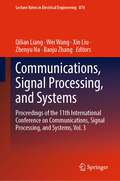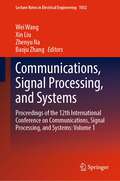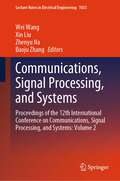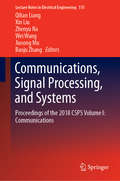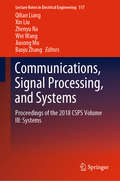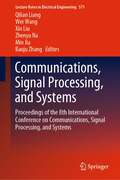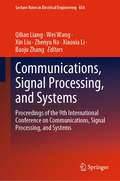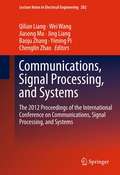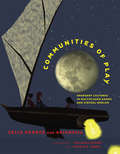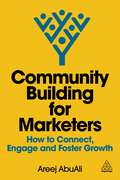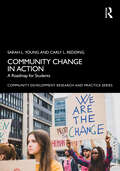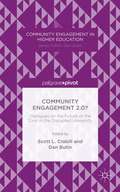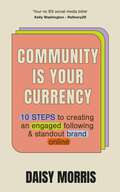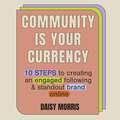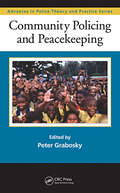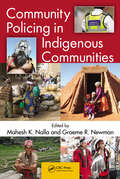- Table View
- List View
Communications and Networking: An Introduction (Undergraduate Topics in Computer Science)
by John CowleyThis textbook presents a detailed introduction to the essentials of networking and communications technologies. Revised and updated, this new edition retains the step-by-step approach of the original, organised to help those without a strong knowledge of the subject matter. Features: provides chapter-ending summaries and review questions, an Appendix on TCP/IP packet formats and an expanded Glossary; supplies supplementary material at the associated Springer website, including teaching slides, solutions to the end-of-chapter questions and supplementary exercises with solutions; presents a greater emphasis on mobile computing and network security, and extended coverage of IPv6 (NEW); discusses networking models and standards, local area and wide area networks, network protocols, TCP/IP-based networks, network management and wireless communications; examines grid and cloud computing, microblogging, mobile ad hoc networks, near-field communication, Power over Ethernet and the Ground Positioning System (NEW).
Communications, Networking, and Information Systems: First International Congress, CNIS 2023, Guilin, China, March 25–27, 2023, Revised Selected Papers (Communications in Computer and Information Science #1839)
by Lipo Wang Pingyi Fan Haonan ChenThis volume constitutes selected papers presented at the First International Congress on Communications, Networking, and Information Systems, CNIS 2023, held in Guilin, China, in March 2023. The 8 full papers and 2 short papers presented were thoroughly reviewed and selected from the 32 submissions. The papers are organized in topical sections on communications and networking, and information systems and artificial intelligence.
Communications, Signal Processing, and Systems: Proceedings of the 10th International Conference on Communications, Signal Processing, and Systems, Vol. 2 (Lecture Notes in Electrical Engineering #879)
by Qilian Liang Wei Wang Baoju Zhang Xin Liu Zhenyu NaThis book brings together papers presented at the 2021 International Conference on Communications, Signal Processing, and Systems, which provides a venue to disseminate the latest developments and to discuss the interactions and links between these multidisciplinary fields. Spanning topics ranging from communications, signal processing and systems, this book is aimed at undergraduate and graduate students in Electrical Engineering, Computer Science and Mathematics, researchers and engineers from academia and industry as well as government employees (such as NSF, DOD and DOE).
Communications, Signal Processing, and Systems: Proceedings of the 10th International Conference on Communications, Signal Processing, and Systems, Vol.1 (Lecture Notes in Electrical Engineering #878)
by Qilian Liang Wei Wang Baoju Zhang Xin Liu Zhenyu NaThis book brings together papers presented at the 2021 International Conference on Communications, Signal Processing, and Systems, which provides a venue to disseminate the latest developments and to discuss the interactions and links between these multidisciplinary fields. Spanning topics ranging from communications, signal processing and systems, this book is aimed at undergraduate and graduate students in Electrical Engineering, Computer Science and Mathematics, researchers and engineers from academia and industry as well as government employees (such as NSF, DOD and DOE).
Communications, Signal Processing, and Systems: Proceedings of the 11th International Conference on Communications, Signal Processing, and Systems, Vol. 1 (Lecture Notes in Electrical Engineering #872)
by Qilian Liang Wei Wang Baoju Zhang Xin Liu Zhenyu NaThis book brings together papers presented at the 2022 International Conference on Communications, Signal Processing, and Systems, online, July 23-24, 2022, which provides a venue to disseminate the latest developments and to discuss the interactions and links between these multidisciplinary fields. Spanning topics ranging from communications, signal processing and systems, this book is aimed at undergraduate and graduate students in Electrical Engineering, Computer Science and Mathematics, researchers and engineers from academia and industry as well as government employees (such as NSF, DOD and DOE).
Communications, Signal Processing, and Systems: Proceedings of the 11th International Conference on Communications, Signal Processing, and Systems, Vol. 2 (Lecture Notes in Electrical Engineering #873)
by Qilian Liang Wei Wang Baoju Zhang Xin Liu Zhenyu NaThis book brings together papers presented at the 2021 International Conference on Communications, Signal Processing, and Systems, Changbaishan, China, July 23-24, 2022, which provides a venue to disseminate the latest developments and to discuss the interactions and links between these multidisciplinary fields. Spanning topics ranging from communications, signal processing and systems, this book is aimed at undergraduate and graduate students in Electrical Engineering, Computer Science and Mathematics, researchers and engineers from academia and industry as well as government employees (such as NSF, DOD and DOE).
Communications, Signal Processing, and Systems: Proceedings of the 11th International Conference on Communications, Signal Processing, and Systems, Vol. 3 (Lecture Notes in Electrical Engineering #874)
by Qilian Liang Wei Wang Baoju Zhang Xin Liu Zhenyu NaThis book brings together papers presented at the 2022 International Conference on Communications, Signal Processing, and Systems, online, July 23-24, 2022, which provides a venue to disseminate the latest developments and to discuss the interactions and links between these multidisciplinary fields. Spanning topics ranging from communications, signal processing and systems, this book is aimed at undergraduate and graduate students in Electrical Engineering, Computer Science and Mathematics, researchers and engineers from academia and industry as well as government employees (such as NSF, DOD and DOE).
Communications, Signal Processing, and Systems: Proceedings of the 12th International Conference on Communications, Signal Processing, and Systems: Volume 1 (Lecture Notes in Electrical Engineering #1032)
by Wei Wang Baoju Zhang Xin Liu Zhenyu NaThis book brings together papers presented at the 2023 International Conference on Communications, Signal Processing, and Systems, which provides a venue to disseminate the latest developments and to discuss the interactions and links between these multidisciplinary fields. Spanning topics ranging from Communications, Signal Processing, and Systems, this book is aimed at undergraduate and graduate students in Electrical Engineering, Computer Science and Mathematics, researchers and engineers from academia and industry as well as government employees (such as NSF, DOD, DOE).
Communications, Signal Processing, and Systems: Proceedings of the 12th International Conference on Communications, Signal Processing, and Systems: Volume 2 (Lecture Notes in Electrical Engineering #1033)
by Wei Wang Baoju Zhang Xin Liu Zhenyu NaThis book brings together papers presented at the 2023 International Conference on Communications, Signal Processing, and Systems, which provides a venue to disseminate the latest developments and to discuss the interactions and links between these multidisciplinary fields. Spanning topics ranging from Communications, Signal Processing, and Systems, this book is aimed at undergraduate and graduate students in Electrical Engineering, Computer Science and Mathematics, researchers and engineers from academia and industry as well as government employees (such as NSF, DOD, DOE).
Communications, Signal Processing, and Systems: Proceedings of the 2018 CSPS Volume I: Communications (Lecture Notes in Electrical Engineering #515)
by Qilian Liang Wei Wang Jiasong Mu Baoju Zhang Xin Liu Zhenyu NaThis book brings together papers from the 2018 International Conference on Communications, Signal Processing, and Systems, which was held in Dalian, China on July 14–16, 2018. Presenting the latest developments and discussing the interactions and links between these multidisciplinary fields, the book spans topics ranging from communications, signal processing and systems. It is aimed at undergraduate and graduate electrical engineering, computer science and mathematics students, researchers and engineers from academia and industry as well as government employees.
Communications, Signal Processing, and Systems: Proceedings of the 2018 CSPS Volume III: Systems (Lecture Notes in Electrical Engineering #517)
by Qilian Liang Wei Wang Jiasong Mu Baoju Zhang Xin Liu Zhenyu NaThis book brings together papers from the 2018 International Conference on Communications, Signal Processing, and Systems, which was held in Dalian, China on July 14–16, 2018. Presenting the latest developments and discussing the interactions and links between these multidisciplinary fields, the book spans topics ranging from communications, signal processing and systems. It is aimed at undergraduate and graduate electrical engineering, computer science and mathematics students, researchers and engineers from academia and industry as well as government employees.
Communications, Signal Processing, and Systems: Proceedings of the 8th International Conference on Communications, Signal Processing, and Systems (Lecture Notes in Electrical Engineering #571)
by Qilian Liang Wei Wang Baoju Zhang Xin Liu Min Jia Zhenyu NaThis book brings together papers from the 2019 International Conference on Communications, Signal Processing, and Systems, which was held in Urumqi, China, on July 20–22, 2019. Presenting the latest developments and discussing the interactions and links between these multidisciplinary fields, the book spans topics ranging from communications to signal processing and systems. It is chiefly intended for undergraduate and graduate students in electrical engineering, computer science and mathematics, researchers and engineers from academia and industry, as well as government employees.
Communications, Signal Processing, and Systems: Proceedings of the 9th International Conference on Communications, Signal Processing, and Systems (Lecture Notes in Electrical Engineering #654)
by Qilian Liang Wei Wang Baoju Zhang Xin Liu Zhenyu Na Xiaoxia LiThis book brings together papers presented at the 2020 International Conference on Communications, Signal Processing, and Systems, which provides a venue to disseminate the latest developments and to discuss the interactions and links between these multidisciplinary fields. Spanning topics ranging from communications, signal processing and systems, this book is aimed at undergraduate and graduate students in Electrical Engineering, Computer Science and Mathematics, researchers and engineers from academia and industry as well as government employees (such as NSF, DOD and DOE).
Communications, Signal Processing, and Systems: The 2012 Proceedings of the International Conference on Communications, Signal Processing, and Systems (Lecture Notes in Electrical Engineering #202)
by Qilian Liang Yiming Pi Wei Wang Jiasong Mu Jing Liang Baoju Zhang Chenglin ZhaoCommunications, Signal Processing, and Systems is a collection of contributions coming out of the International Conference on Communications, Signal Processing, and Systems (CSPS) held August 2012. This book provides the state-of-art developments of Communications, Signal Processing, and Systems, and their interactions in multidisciplinary fields, such as audio and acoustic signal processing. The book also examines Radar Systems, Chaos Systems, Visual Signal Processing and Communications and VLSI Systems and Applications. Written by experts and students in the fields of Communications, Signal Processing, and Systems.
Communities of Play: Emergent Cultures in Multiplayer Games and Virtual Worlds (The\mit Press Ser.)
by Celia PearceThe odyssey of a group of “refugees” from a closed-down online game and an exploration of emergent fan cultures in virtual worlds.Play communities existed long before massively multiplayer online games; they have ranged from bridge clubs to sports leagues, from tabletop role-playing games to Civil War reenactments. With the emergence of digital networks, however, new varieties of adult play communities have appeared, most notably within online games and virtual worlds. Players in these networked worlds sometimes develop a sense of community that transcends the game itself. In Communities of Play, game researcher and designer Celia Pearce explores emergent fan cultures in networked digital worlds—actions by players that do not coincide with the intentions of the game's designers. Pearce looks in particular at the Uru Diaspora—a group of players whose game, Uru: Ages Beyond Myst, closed. These players (primarily baby boomers) immigrated into other worlds, self-identifying as “refugees”; relocated in There.com, they created a hybrid culture integrating aspects of their old world. Ostracized at first, they became community leaders. Pearce analyzes the properties of virtual worlds and looks at the ways design affects emergent behavior. She discusses the methodologies for studying online games, including a personal account of the sometimes messy process of ethnography. Pearce considers the “play turn” in culture and the advent of a participatory global playground enabled by networked digital games every bit as communal as the global village Marshall McLuhan saw united by television. Countering the ludological definition of play as unproductive and pointing to the long history of pre-digital play practices, Pearce argues that play can be a prelude to creativity.
Community Building for Marketers: How to Connect, Engage and Foster Growth
by Areej AbuAliThe fastest growing brands of the 21st century have succeeded by building and harnessing the power of brand communities. In doing so, they were able to earn engagement and loyalty, with relatively low risk. Community Building for Marketers looks at how brands have successfully mastered community marketing and how you can do it too. Covering everything from how to start and grow a successful community, to setting your community's vision, mission and values, as well as defining what success looks like for you, this book is the ultimate step-by-step guide. With real-world examples from a wide range of companies such as Buffer, Sanity and The TEFL Org, this book is designed to help you succeed at community marketing no matter what type of business you're in. Whether your community is still in its early days or has been around for a while and needs a boost, Community Building for Marketers will help you capitalize upon the opportunities community marketing offers, transforming your customers from passive consumers to active, engaged brand advocates.
Community Change in Action: A Roadmap for Students (Community Development Research and Practice Series)
by Sarah L. Young Carly L. ReddingCommunity Change in Action guides students through the process of turning their personal passion into goal-driven action for community development. Using an evidence-based curriculum, the book breaks down exactly how to initiate and drive social change in a way that speaks to the unique characteristics of Generation Z (Gen Z).Each chapter provides step-by-step actions, analyzes real-life examples, and supplies the necessary tools for success. The authors' multiple decades of experience leading students in community development, both in the United States and abroad, spawn a rich and engaging source for these examples. Each step is highlighted through Gen Z's narrated examples of using the guide and the associated toolkits to implement major social change initiatives, from Native American reservations to the slums of India and beyond.This book takes best practice approaches to youth leadership, community development, and social change beyond the classroom, inspiring and illustrating how Gen Z students can take their passion and turn it into social action.
Community Engagement 2.0?: Dialogues on the Future of the Civic in the Disrupted University
by Scott L. Crabill Dan ButinAs higher education is disrupted by technology and takes place less and less on campus, what does meaningful community engagement look like? How can it continue to enrich learning? In Community Engagement 2. 0?, Crabill and Butin convene a dialogue: five writers set out theoretical and practical considerations, five more discuss the issues raised.
Community Informatics Design Applied to Digital Social Systems
by Pierre-Léonard Harvey Virginie BuccoThis book introduces a Digital Social System Praxis Framework (DSSPF) integrating Computational Media, Evolutionary Systems Thinking and Design Thinking approaches to E-transformation practice, also called Community Informatics Design (CID). The DSSPF framework is intended to create communication spaces dedicated to knowledge production and sharing for social and organizational change. It allows social systems researchers and practitioners to recognize their synergistic roles in the praxis process to shape their future through social innovation projects. This transdisciplinary text provides potential students and practitioners fundamental concepts and tools for such design. It offers resources from the Pragmatic and Systemic philosophy of science for the co-construction of social architectures and infrastructures, and multi-aspectual design methodologies by which government, organizations and civil society can learn to ethically co-design common ground. This approach provides complementary and common patterns from known methods, models, and theories of social systems interventions that could support a generic framing of large scale sociotechnical systems: digital social innovation ecosystem, living Labs, Fab Labs, enterprise collaborative networks.There will be a particular focus on understanding and addressing the dimensions that make people from different communities of practice able to communicate and collaborate through multiple digital media, design platforms, worldviews and modeling approaches.
Community Is Your Currency: 10 Steps to Creating A Thriving Online Community & Growing Your Business
by Daisy MorrisAre you looking to supercharge your business and grow your online community? The key to a booming business is your community. Founder of social media consultancy The Selfhood, Daisy Morris, is here with the ultimate guide for all the side-hustlers, creators, business owners and freelancers looking to build a genuine community on social media. This book drops the jargon - Daisy will teach you how to take your community on a journey. From brand awareness through to conversion, you will have the confidence to expand your reach while nurturing your existing fans, followers, subscribers and customers to turn them in to loyal and repeat customers. You will learn how to create meaningful connections with your audience, through real-life case studies, simple exercises and top-notch business advice. A must-read for any business owner.
Community Is Your Currency: 10 Steps to Creating A Thriving Online Community & Growing Your Business
by Daisy MorrisAre you looking to supercharge your business and grow your online community? The key to a booming business is your community. Founder of social media consultancy The Selfhood, Daisy Morris, is here with the ultimate guide for all the side-hustlers, creators, business owners and freelancers looking to build a genuine community on social media. This book drops the jargon - Daisy will teach you how to take your community on a journey. From brand awareness through to conversion, you will have the confidence to expand your reach while nurturing your existing fans, followers, subscribers and customers to turn them in to loyal and repeat customers. You will learn how to create meaningful connections with your audience, through real-life case studies, simple exercises and top-notch business advice. A must-read for any business owner.
Community Is Your Currency: 10 Steps to Creating A Thriving Online Community & Growing Your Business
by Daisy MorrisA 10-step guide to cultivating a thriving online community and growing your business by the founder of social media consultancy and digital community The Selfhood.Are you looking to supercharge your business and grow your online community? The key to a booming business is your community. Founder of social media consultancy The Selfhood, Daisy Morris, is here with the ultimate guide for all the side-hustlers, creators, business owners and freelancers looking to build a genuine community on social media. This audiobook drops the jargon - Daisy will teach you how to take your community on a journey. From brand awareness through to conversion, you will have the confidence to expand your reach while nurturing your existing fans, followers, subscribers and customers to turn them in to loyal and repeat customers. You will learn how to create meaningful connections with your audience, through real-life case studies, simple exercises and top-notch business advice. A must-listen for any business owner.(P)2023 Hodder & Stoughton Limited
Community Newspapers in India: Manifestation and Metamorphosis
by Annapurna SinhaThis book provides a comprehensive account of community newspapers in India discussing their reach, practices, management and influence on communities. It focuses on the core characteristics associated with community media, such as access and participation, advocacy and self-management among other. With the help of detailed case studies of two established newspapers – Khabar Lahariya and Namaskar, the book highlights the unique aspects of their rhizomatic expansion and the practices for social change. By examining their manifestations and metamorphosis, the book shows how community media is fluid and evolves with time owing to diverse motivations. The author also examines themes such as media democracy and citizens engagement; role of alternative media and the diversity of practices and profiles to highlight the relevance, identity and purpose of alternative media in general and community newspapers in particular. This book will be of interest to scholars and researchers of media studies, journalism and mass communication, political studies, development studies, law and South Asian studies. It will also be useful to NGOs and CSOs working in the areas of community engagement, social development and empowerment, and literacy.
Community Policing and Peacekeeping (Advances in Police Theory and Practice)
by Peter GraboskyIn modern industrial societies, the demand for policing services frequently exceeds the current and foreseeable availability of public policing resources. Conversely, developing nations often suffer from an inability to provide a basic level of security for their citizens. Community Policing and Peacekeeping offers a fresh overview of the challenge
Community Policing in Indigenous Communities
by Mahesh K. Nalla Graeme R. NewmanIndigenous communities are typically those that challenge the laws of the nation states of which they have become often very reluctantly a part. Around the world, community policing has emerged in many of these regions as a product of their physical environments and cultures. Through a series of case studies, Community Policing in Indigenous Commun
